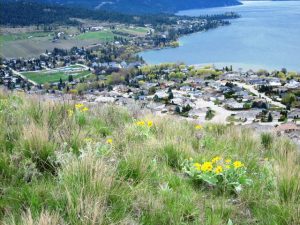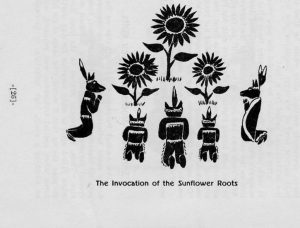Cariboo sunflowers are a beautiful marker of spring and in the not-too-distant past they were also an important food crop for the First Nations peoples of the BC interior. This plant, also known as arrowleaf balsamroot (Balsamorhiza sagittata), is a member of the aster family. Nowadays it grows plentifully on hillsides and grasslands. 

Root vegetables such as balsamroot and avalanche lily were important sources of carbohydrates for First Nations peoples of BC. Balsamroot shoots, which appeared in the early spring, were considered good “famine food, being available when few other foods could be found”[ii]. All parts of balsamroot can be eaten: the leaves can be steamed or eaten raw; the taproots can be dried, roasted or steamed; and the seeds can be pounded for use as a flour or eaten raw [iii].
First Nations peoples managed the crop by never harvesting the “mother” roots which could be as big as a person’s forearm and several decades old[i]. Women always dug the balsam root with root-digging sticks made of wood or antlers. The preferred size of root to dig was about carrot-sized.Once dug, the roots were cooked, dried and stored. Balsamroot was pit-cooked before or after being dried. A pit would be lined with vegetation such as Douglas fir boughs and left to cook for 24 hours or more. The long cooking was needed to break down inulin, a compound that is not very digestible, into fructose, the kind of sugar found in fruit and honey. Cooked balsamroot was considered a “treat or dessert” according to Dr. Nancy Turner in Food Plants of Interior First Peoples[iv] .
The root had medicinal uses; it could be boiled to produce resin used as a poultice for burns and cuts. Several rituals were associated with the preparation of balsamroot. One tradition according to the ethnologist James Teit was for young people to offer a prayer when eating balsamroot for the first time each season[v]. “Meet Mr. Coyote”, a small booklet prepared in 1940 by Noel Stewart, a teacher at St. George’s Indian Residential School in Lytton, BC, included the following whimsical drawing by his students. It shows young coyotes around a Cariboo sunflower-like plant [vi].
There has been some discussion on whether balsamroot can be produced as a commercial crop. Elders have said that balsamroot was much bigger in the old days – the roots were easier to dig. As well it does not germinate or transplant readily [vii]. Perhaps it best serves as a reminder of a self-sufficient time.
For further information about ethnobotany, a recent book by Nancy Turner, Ancient Pathways, Ancestral Knowledge: Ethnobotany and Ecological Wisdom of Indigenous Peoples of Northwestern North America is considered the “gold standard” for the complex relationships between people and plants[viii] .
[i] Turner, N.J., Deur, D. & Lepofsky, D. (2013). Plant management systems of British Columbia’s First Peoples. BC Studies: The British Columbia Quarterly, 179, 107-133.
[ii] Turner, N. (1997). Food Plants of Interior First Peoples. Vancouver and Victoria: UBC Press with Royal British Columbia Museum.
[iii] http://www.bcadventure.com/adventure/wilderness/wildflowers/balsam.htm
[iv] Turner, N. (1997). Food Plants of Interior First Peoples. Vancouver and Victoria: UBC Press with Royal British Columbia Museum. p. 93.
[v] Teit, J. (1912). Traditions of the Lillooet Indians of British Columbia. The Journal of American Folklore, 25 (98), pp. 287-371.
[vi] de Zwart, M.L. (2011). Meet Mr. Coyote. B.C. History Magazine, 44 (1), 18-22.
[vii] Chambers, K..(2006). Ethylene improves germination of arrow-leaved balsamroot seeds. Native Plants Journal, 7 (2), pp. 108-113.
[viii] Turner, N. (2014). Ancient Pathways, Ancestral Knowledge: Ethnobotany and Ecological Wisdom of Indigenous Peoples of Northwestern North America. Montreal & Kingston: McGill-Queen’s University Press, 2014


